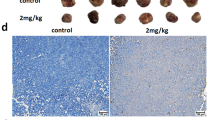Abstract
Purpose. Non-nitrogen-containing bisphosphonates, such as clodronate (dichloromethylene bisphosphonate), appear to act as prodrugs, their active form being the AppCp-type analogues of ATP. To further elucidate this, we examined the cellular uptake of clodronate and intracellular accumulation of the metabolite of clodronate (AppCCl2p) in RAW 264 macrophages, the influence of clodronate metabolism on the intracellular ATP concentration, and the time course of clodronate metabolism and the effects of clodronate on cytokine secretion from macrophages.
Methods. The cellular uptake of clodronate was measured using 14C-labeled clodronate. AppCCl2p was determined in cell extracts by using an ion-pairing HPLC-ESI-MS. The cytokine concentrations in the culture supernatants were measured with time-resolved fluoroimmunoassay. Intracellular ATP concentration was measured with a luminometer using a luciferin-luciferase assay.
Results. Of the clodronate internalized by macrophages in vitro, 30-55% is metabolized to AppCCl2p, which accumulates to high intracellular concentrations during the first 12 h of exposure. This accumulation does not affect the ATP levels in the cells. The time course of metabolite appearance in the cells and the inhibition of cytokine secretion were very similar.
Conclusions. These results strongly support the idea that clodronate acts as a prodrug, the active form being its intracellular AppCCl2p metabolite.
Similar content being viewed by others
REFERENCES
M. J. Rogers, S. Gordon, F. P. Coxon, H. L. Benford, S. P. Luckman, J. Mönkkönen, and J. C. Frith. Cellular and molecular mechanisms of action of bisphosphonates. Cancer 88:2961-2978 (2000).
M. J. Rogers, R. G.G. Russell, G. M. Blackburn, M. P. Williamson, and D. J. Watts. Metabolism of halogenated bisphosphonates by the cellular slime mould Dictyostelium discoideum. Biochem. Biophys. Res. Commun. 189:414-423 (1992).
M. J. Rogers, X. Ji, R. G.G. Russell, G. M. Blackburn, M. P. Williamson, A. V. Bayless, F. H. Ebetino, and D. J. Watts. Incorporation of bisphosphonates into adenine nucleotides by amoebae of the cellular slime mould Dictyostelium discoideum. Biochem. J. 303:303-311 (1994).
S. Pelorgeas, J. B. Martin, and M. Satre. Cytotoxicity of dichloromethane diphosphonate and of 1-hydroxyethane-1,1-diphosphonate in the amoebae of the slime mould Dictyostelium discoideum. A 31P NMR study. Biochem. Pharmacol. 44:2157-2163 (1992).
M. J. Rogers, R. J. Brown, V. Hodkin, G. M. Blackburn, R. G. G. Russell, and D. J. Watts. Bisphosphonates are incorporated into adenine nucleotides by human aminoacyl-tRNA synthetase enzymes. Biochem. Biophys. Res. Commun. 224:863-869 (1996).
J. C. Frith, J. Mönkkönen, G. M. Blackburn, R. G.G. Russell, and M. J. Rogers. Clodronate and liposome-encapsulated clodronate are metabolized to a toxic ATP analog, adenosine 5′-(β,γ-dichloromethylene) triphosphate, by mammalian cells in vitro. J. Bone. Miner. Res. 12:1358-1367 (1997).
S. Auriola, J. C. Frith, M. J. Rogers, A. Koivuniemi, and J. Mönkkönen. Identification of adenine nucleotide-containing metabolites of bisphosphonate drugs using ion-pair liquid chromatography-electrospray mass spectrometry. J. Chromatogr. B 704:187-195 (1998).
N. Makkonen, A. Salminen, M. J. Rogers, J. C. Frith, A. Urtti, E. Azhayeva, and J. Mönkkönen. Contrasting effects of alendronate and clodronate on RAW 264 macrophages: the role of a bisphosphonate metabolite. Eur. J. Pharm. Sci. 8:109-118 (1999).
N. Pennanen, S. Lapinjoki, A. Urtti, and J. Mönkkönen. Effect of liposomal and free bisphosphonates on the IL-1β, IL-6, and TNFα secretion from RAW 264 cells in vitro. Pharm. Res. 12:916-922 (1995).
N. Makkonen, M-R. Hirvonen, T. Teräväinen, K. Savolainen, and J. Mönkkönen. Different effects of three bisphosphonates on nitric oxide production by RAW 264 macrophage-like cells in vitro. J. Pharmacol. Exp. Ther. 277:1097-1102 (1996).
R. W. Kinne, C. B. Schmidt-Weber, R. Hoppe, E. Buchner, E. Palombo-Kinne, E. Nurnberg, and F. Emmrich. Long-term amelioration of rat adjuvant arthritis following systemic elimination of macrophages by clodronate-containing liposomes. Arthritis Rheum. 38:1777-1790 (1995).
P. J. Richards, A. S. Williams, R. M. Goodfellow, and B. D. Williams. Liposomal clodronate eliminates synovial macrophages, reduces inflammation and ameliorates joint destruction in antigen-induced arthritis. Rheumatology 38:818-825 (1999).
P. Barrera, A. Blom, P. van Lent, L. van Bloois, J. Beijnen, N. van Rooijen, M. de Malefijt, L. van de Putte, G. Storm, and W. van den Berg. Synovial macrophage depletion with clodronate-containing liposomes in rheumatoid arthritis. Arthritis Rheum. 43:1951-1959 (2000).
A. Ceponis, E. Waris, J. Mönkkönen, L. Laasonen, M. Hyttinen, S. A. Solovieva, R. Hanemaajier, A. Bitsch, and Y. T. Konttinen. Low-dose, non-cytotoxic intra-articular liposomal clodronate delays development of erosions and prevents loss of cartilage proteoglycan in established antigen-induced arthritis (AIA) in rabbits. Arth. Rheum. 44:1908-1916 (2001).
J. Mönkkönen, R. Valjakka, M. Hakasalo, and A. Urtti. The effects of liposome surface charge and size on the intracellular delivery of clodronate and gallium in vitro. Int. J. Pharm. 107:189-197 (1994).
J. Mönkkönen, M. Taskinen, S. Auriola, and A. Urtti. Growth inhibition of macrophage-like and other cell types by liposome encapsulated, calcium-bound, and free bisphosphonates in vitro. J. Drug Target. 2:299-308 (1994).
H. Mönkkönen, P. Moilanen, J. Mönkkönen, F. C. Frith, M. J. Rogers, and S. Auriola. Analysis of an adenine nucleotide-containing metabolite of clodronate using ion pair high-performance liquid chromatography electrospray ionization mass spectrometry. J. Chromatogr. B 738:395-403 (2000).
N. Pennanen, S. Lapinjoki, A. Palander, A. Urtti, and J. Mönkkönen. Macrophage-like RAW 264 cell line and time-resolved fluoroimmunoassay (TRFIA) as tools in screening drug effects on cytokine secretion. Int. J. Immunopharmacol. 17:475-480 (1995).
A. Werner, R. Maeba, H. Shimasaki, N. Ueta, and G. Gerber. Purine and pyrimidine compounds in murine peritoneal macrophages cultured in vitro. J. Chromatogr. 553:205-210 (1991).
A. Bidani and T. A. Heming. Effects of lidocaine on cytosolic pH regulation and stimulus-induced effector functions in alveolar macrophages. Lung 175:349-361 (1997).
J. Mönkkönen and T. D. Heath. The effects of liposome-encapsulated and free clodronate on the growth of macrophage-like cells in vitro: The role of calcium and iron. Calcif. Tissue Int. 53:139-146 (1993).
R. Felix, H. L. Guenther, and H. Fleisch. The subcellular distribution of [14C]dichloromethylenebisphosphonate and [14C]1-hydroxyethylidene-1,1-bisphosphonate in cultured calvaria cells. Calcif. Tissue Int. 36:108-113 (1984).
M. J. Rogers, X. Xiong, X. Ji, J. Mönkkönen, R. G.G. Russell, M. P. Williamson, F. H. Ebetino, and D. J. Watts. Inhibition of growth of Dictyostelium discoideum amoebae by bisphosphonate drugs is dependent on cellular uptake. Pharm. Res. 14:625-630 (1997).
D. E. Hughes, K. R. Wright, H. L. Uy, A. Sasaki, T. Yoneda, G. D. Roodman, G. R. Mundy, and B. F. Boyce. Bisphosphonates promote apoptosis in murine osteoclasts in vitro and in vivo. J. Bone Miner. Res. 10:1478-1487 (1995).
K. S. Selander, J. Mönkkönen, E. K. Karhukorpi, P. Harkonen, R. Hannuniemi, and H. K. Väänänen. Characteristics of clodronate-induced apoptosis in osteoclasts and macrophages. Mol. Pharmacol. 50:1127-1138 (1996).
P. P. Lehenkari, I. Hassinen, K. V. Ylitalo, J. Mönkkönen, M. J. Rogers, A. Azhayev, and H. K. Väänänen. The mechanism of action of non-amino bisphosphonates—evidence for inhibition of the mitochondrial ADP/ATP exchanger by clodronate metabolite. Bone 26:30S (2000).
J. H. Lin. Bisphosphonates: A review of their pharmacokinetics properties. Bone 18:75-85 (1996).
M. Sato, W. Grasser, N. Endo, R. Akins, H. Simmons, D.D Thompson, E. Golub, and G.A Rodan. Bisphosphonate action. Alendronate localization in rat bone and effects on osteoclast ultrastructure. J. Clin. Invest. 88:2095-2105 (1991).
J. Frith, J. Mönkkönen, S. Auriola, H. Mönkkönen, and M. Rogers. Clodronate is metabolised in vivo to an ATP analogue that inhibits bone resorption and causes osteoclast apoptosis. Arthritis Rheum. in press.
Author information
Authors and Affiliations
Rights and permissions
About this article
Cite this article
Mönkkönen, H., Rogers, M.J., Makkonen, N. et al. The Cellular Uptake and Metabolism of Clodronate in RAW 264 Macrophages. Pharm Res 18, 1550–1555 (2001). https://doi.org/10.1023/A:1013026313647
Issue Date:
DOI: https://doi.org/10.1023/A:1013026313647




